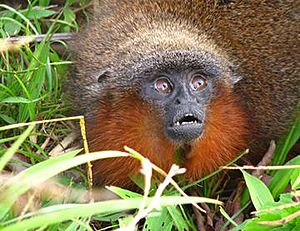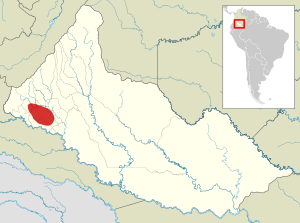Caquetá titi monkey facts for kids
Quick facts for kids Caquetá titi |
|
|---|---|
 |
|
| Conservation status | |
| Scientific classification | |
| Genus: |
Plecturocebus
|
| Species: |
caquetensis
|
 |
|
| P. caquetensis on map of Caquetá department, Colombia | |
| Synonyms | |
|
Callicebus caquetensis |
|
The Caquetá titi monkey (Plecturocebus caquetensis) is a special kind of titi monkey that lives only in Colombia. You can find it in the Department of Caquetá region. It's also known as the red-bearded titi or the bushy-bearded titi because of its unique look. Scientists first described this monkey in 2010. Sadly, it is in great danger of disappearing because its home is being broken up into smaller pieces, and there aren't many of them left.
Contents
What does the Caquetá Titi look like?
This monkey usually has brown fur. Its tail is a bit lighter, and its belly, neck, and cheeks are a reddish-brown color, like chestnuts. It looks a lot like two other titi monkeys: the ornate titi and the white-tailed titi. However, the Caquetá titi doesn't have a white stripe on its forehead, and its hands and feet aren't white like the ornate titi's. A special feature of this monkey is its red beard!
Its body is about 35 centimeters (14 inches) long, and its tail is much longer, around 61 centimeters (24 inches). These monkeys usually weigh between 800 and 1400 grams (about 1.7 to 3 pounds).
Where do Caquetá Titis live?
The Caquetá titi monkey lives in the Department of Caquetá in Colombia. You can find them in areas between the Río Orteguaza and the Río Caquetá rivers. They live at heights of about 190 to 260 meters (620 to 850 feet) above sea level. Scientists are still trying to figure out exactly how far their living area stretches.
Why are Caquetá Titis in danger?
Scientists believe the Caquetá titi monkey is Critically Endangered. This means it faces a very high risk of becoming extinct in the wild. Experts think there might be fewer than 250 adult monkeys left.
These monkeys live in forests that have been cut up by farming. It's very hard for them to move between small forest areas because they have to cross open grassy fields or even barbed wire fences. Their total living area is only about 100 square kilometers (39 square miles), but they actually only use about 10 square kilometers (3.9 square miles) of that space.
The Caquetá titi was even listed among the World’s 25 Most Endangered Primates in 2017. Satellite pictures show that between 1989 and 2002, half of the original forests where these monkeys live were destroyed. The amount of pasture land (for animals to graze) doubled. By 2002, only 32% of the area still had some forest cover. The best forests for the monkeys are now only found along the banks of the Orteguaza and Caquetá rivers.
How do Caquetá Titis live?
Scientists have studied 13 groups of Caquetá titi monkeys. Each group usually has one adult male, one adult female, and one to four younger monkeys. On average, a group has about 4 monkeys. This is similar to other titi monkey species. They live in small, close-knit families led by a male and female pair.
Like other titi monkeys, they are monogamous, meaning a male and female stay together for life. They usually have about one baby each year. When baby titi monkeys are happy, they make purring sounds, much like a cat!
Their diet mostly consists of fruit. Leaves are the second most important food they eat, and seeds make up only a small part of their diet.
See also
 In Spanish: Tití del Caquetá para niños
In Spanish: Tití del Caquetá para niños
Images for kids




